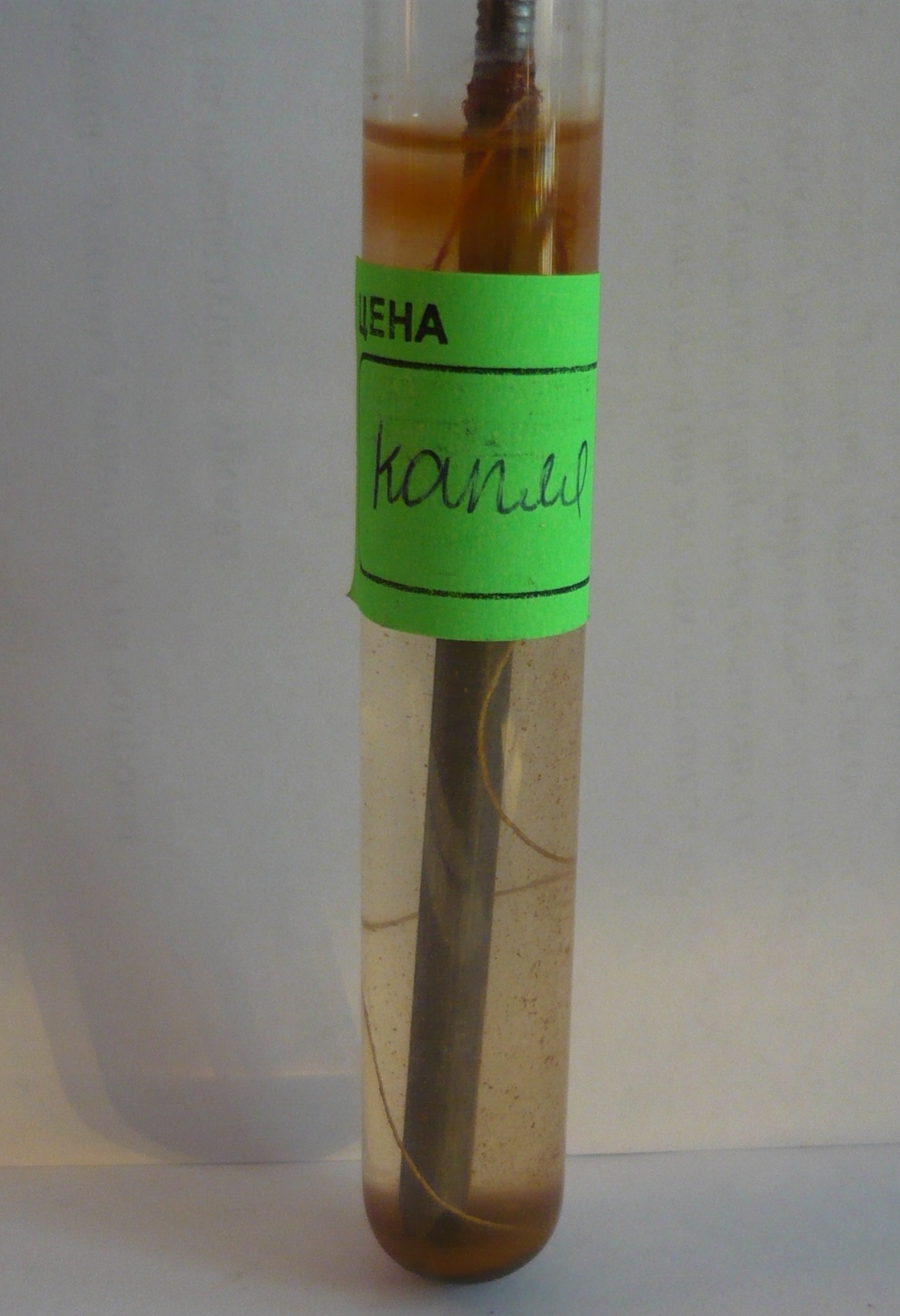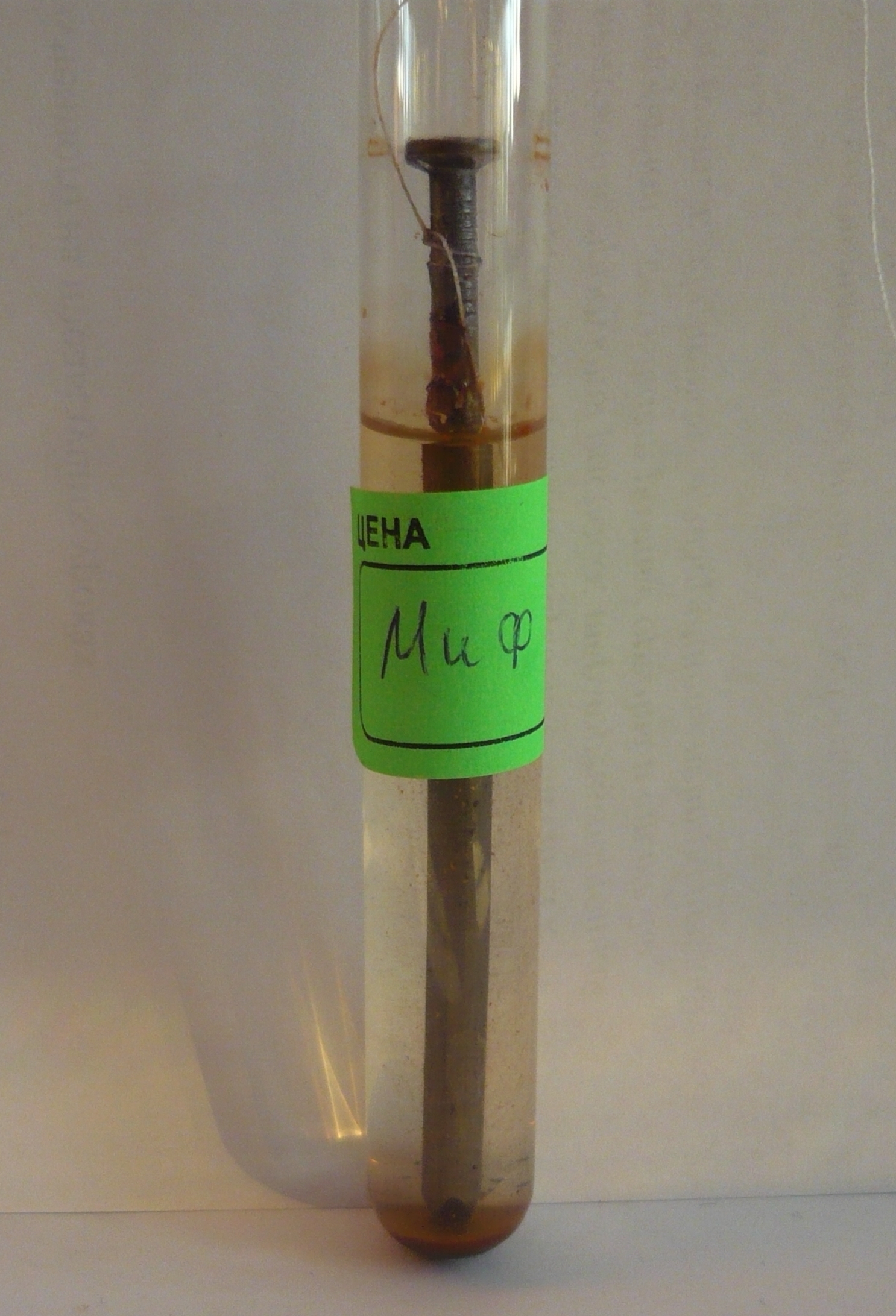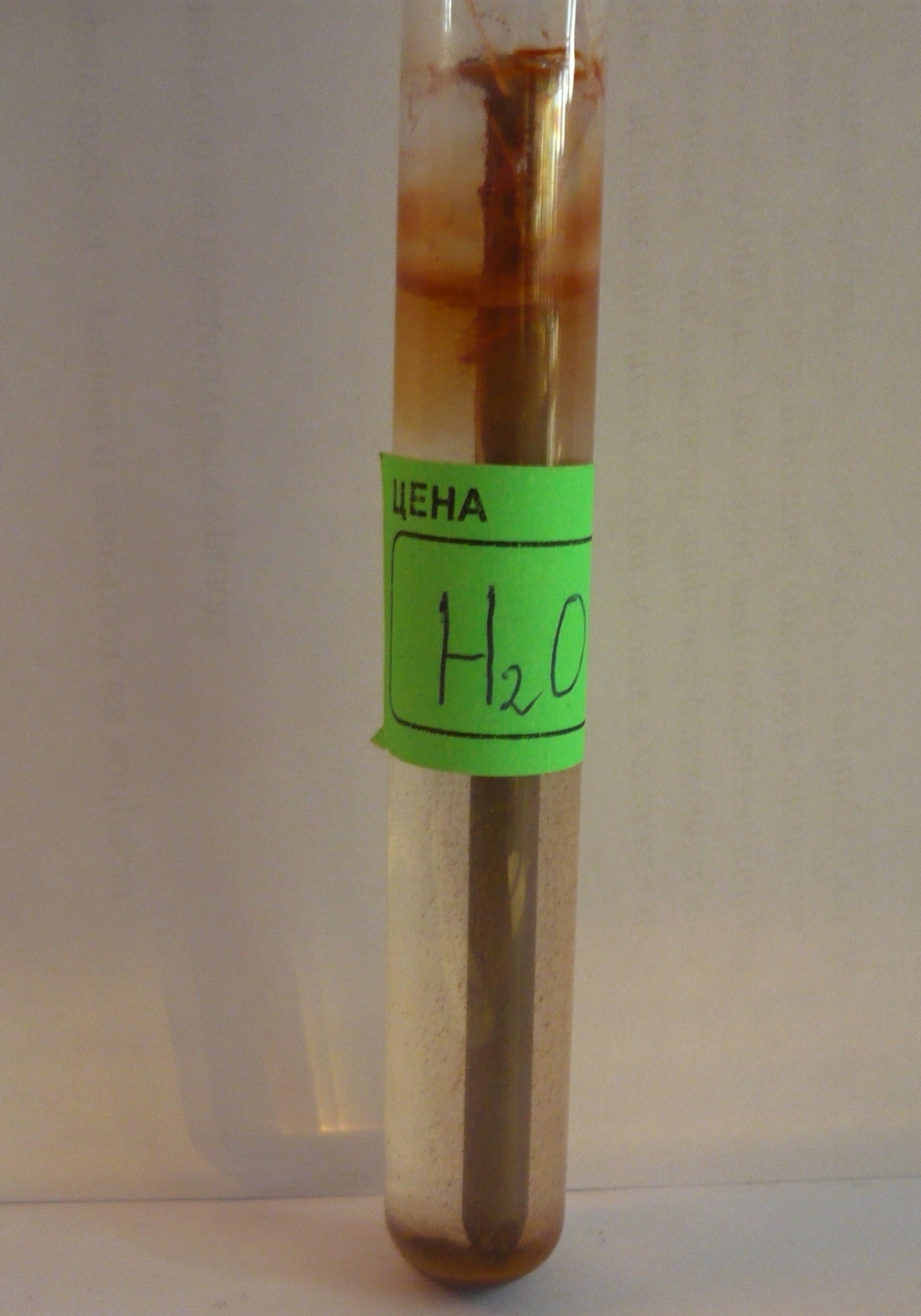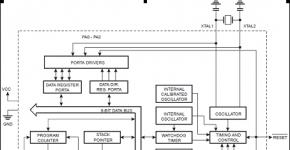Training projects in chemistry. Chemistry research
Chemistry student research
from the experience of a teacher of chemistry Gabdrahmanova T.V.
"MBOU secondary school No. 5", Usinsk, Komi Republic
Doubting we begin to explore
while exploring, we find the truth.
Pierre Abelard
Introduction
One of the main functions of a teacher is to educate and develop the personality of the student. The organization of research activity, which has a significant impact on the personal and professional development of students, is of particular importance.
For many years I have been organizing research work among students in grades 8–11 in chemistry at our school.
Purpose research work is the education of a curious, actively cognizing the world, owning the basics of the ability to learn a student who knows how to listen and hear others.
Tasks:
develop the ability to design their activities (educational, research);
to develop communicative and creative abilities of students;
to improve the skills of working with the methods necessary for conducting research - observation, measurement, experiment;
to draw up the results of work, to present their work at various competitions;
use the experience of students to gain new knowledge;
development of the ability to work independently with various information.
The relevance of research:
the search for the greatest efficiency between the trends of the innovative educational process and traditional student learning technologies;
the need to form a unique creative personality that can think outside the box.
teaching students how to search, organize and process the information received through independent research activities.
Organization of research at chemistry lessons
When organizing research work, theoretical training is required that students receive in traditional classes for the initial consolidation of knowledge.
Students receive elements of research work in chemistry lessons, but at the same time various problems arise, since schoolchildren very vaguely present research methods, stages of work, presentation of the results of their research work. It is difficult for them to select sources of information for the topic, generate ideas, find ways to solve problems, analyze, compare, make generalizations and conclusions, correlate what has been achieved with previously set goals and objectives.When students are theoretically prepared, apply torockywith research elements and study lessons. To stimulate interest in research activities in chemistry classes, it is necessary to create a situation of success.
Lessons with study elements.
Students in the lesson practice individual teaching methods that make up research. What wouldstudents to propose a study is required to form a concept with them about the subject and object of the study, a hypothesis, show methods of testing hypotheses. The research algorithm for students can be proposed by the example of a simple problem problem with chemical content. For example, “What properties should an oxide and hydroxide of an element with serial number 13 have?” (Appendix 1). After completing the work, students can be offered independent research on the problem: “What properties does the hydroxide of a chemical element have if the electronic structure of an atom is expressed by the scheme: 8e; 5th? ” According to the content of elements of research activity, various types of lessons are distinguished: lessons on choosing a topic and a research method, working with sources of information, lessons with an experiment, listening to messages, protecting essays, etc.
In the development of students' research skills, the role of problem education is very important. The problem situation encourages students to think (analysis, synthesis, generalization, specification, etc.). When considering the topic “Corrosion of metals”, a problem situation can be created. The child gives a message in which he talks about the dangers of corrosion. The speaker aims to give a general idea of \u200b\u200bcorrosion and the harm caused by this phenomenon. Lines from the report: “Corrosion causes not only direct damage (about one third of the metal produced per year in the whole world is lost from it every year), but also indirect: metal structures (cars, roofs, monuments, bridges) are destroyed.” We identify the problem that should be solved in the lesson: how to protect metals from corrosion? Students propose and justify methods for protecting metals from corrosion.
A chemical experiment is one of the ways in which students develop research skills. The lesson experiment is used to create a problem situation, as well as a means of confirming or refuting the hypotheses put forward by students. When studying the topic “Hydrolysis of Salt” at the beginning of the lesson, you can conduct a laboratory experiment and determine the environment of salt solutions using universal indicator paper. Observations can be recorded in a table.
After conducting the experiment, together with the students, we raise the problem. We regard salts as a result of a neutralization reaction. Why do salt solutions have a different environment? Based on the well-known knowledge of dissociation, students put forward various hypotheses. Students recall various signs of the classification of acids and bases, analyze the formulas of the proposed salts. During the conversation, students come to the conclusion that hydrolysis is occurring, which is one of the chemical properties of salts.
Study lesson
At the research lesson, students master the methodology of scientific research, establish the stages of scientific knowledge. Students master the research knowledge and skills in stages, gradually increasing the degree of independence of students in their research educational activities.
In research lessons, various forms of student learning are used: individual, group, steam room, collective. Preference is given to working in groups of 2-4 people, since working in a group contributes to the formation of communicative OUUN. To avoid the shortcomings of group work (conflicts, “hide behind someone else’s backs,” etc.), the rules of group work are developed and used..
Workshop
In the workshops, students also work in groups. Each group consisting of 2-3 people receives an experimental task that must be completed during the lesson. During the workshop, an instruction is created for students that, according to certain rules, sequentially establishes the actions of the student.
Based on existing experience, we can offer the following structure of lessons:
Communication topics, goals and objectives of the workshop;
Updating the supporting knowledge and skills of students;
Motivation of student learning activities;
Introducing students to the instruction;
Selection of the necessary didactic materials, training aids and equipment;
Performing student work under the guidance of a teacher;
Compilation of a report;
Discussion and theoretical interpretation of the obtained results.
This structure can be changed depending on the content of the work, student training and the availability of equipment. Lessons are held in the 11th grade, for example, on the subject of “Obtaining, collecting and studying the properties of gases”, “Solving experimental problems in inorganic and organic chemistry”.
In teaching subjects, the main task is, first of all, to interest students in the process of cognition: to teach them to ask questions and try to find answers to them, to be able to explain the results, to draw informed conclusions. The introduction of a research approach enhances the motivation of educational activities in the teaching of chemistry.
School research can be diverse. Students receive research skills in chemistry lessons in practical works that combine a variety of tasks: experimental tasks, design tasks that require theoretical preparation for work, and reflect the main stages of research activity.
When solving experimental problems, students see the connection of chemistry with life, which contributes to the development of interest in studying the subject, as well as to prepare them for the conscious implementation of practical work (Appendix 2). Students' research activities are carried out both in chemistry classes and in extracurricular hours.
Out-of-school research +
- identification of talented and gifted students
Many students are able to engage in research, and even more research activities. It is important to be able to identify talented and capable students. It should be borne in mind that the overall performance of the student is not the main indicator of his real abilities. It is more difficult to identify students' readiness for this type of activity. Necessary find a student who is interested in and who will finish the job.
In the lesson, such children are noticeable when doing practical and laboratory work, drawing up projects, making presentations. When checking such tasks, it is necessary to pay attention to the creative approach to completing tasks, to the use of additional literature. During the presentation of such work, students are invited to discuss on the topic what they liked in this work and what else can be recommended. After the speech, it is proposed to answer several questions aimed at identifying attitudes towards this type of activity.
When analyzing such presentations, attention should be paid to those students who have a steady interest in this type of work. In the future, these children can be invited to participate in research.
- the formation of interest in scientific creativity
Students do not always show interest in research work, so it is necessary to focus on the diligence and responsibility of the student. How to interest a student? To do this, you can use several tricks. First, to convince that participation in research work will be useful in later life, outside of school. Secondly, knowing that adolescents tend to somehow stand out and not look like the majority, then participating in a research project will allow them to feel their special position among classmates. Thirdly, create an atmosphere of competition.
- work with literature
Any activity, and school essay and doctoral dissertation, are impossible without working with sources of literature. It is necessary to explain and show the student that the literary source is the basis of his work. In the course of research, students have to work with various sources of information. The student’s task is to learn how to work with the source, to acquire the skill of independent work, of proper design. It is necessary to give some recommendations when working with literary sources. Explain to students that not all the information collected may be necessary, not to try to include all the material collected in the work.
- practical part of the work
During the practical part, students identify research tasks, put forward hypotheses and test them, conducting theoretical or experimental studies, process the results. The role of the teacher at this stage of the organization of research is not dominant. The teacher cooperates with the student, advises, prompts how to work with equipment, experiment.
Performing scientific research, students acquire the skills of self-creation, self-acquisition of new knowledge, information and their practical application, which will be useful in any field of activity.
- performance at scientific conferences
Scientific and practical student conferences are held annually at the school. The success of a speech at a scientific and practical conference depends on how well and confidently students can present their work in the section, prepare a computer presentation, and the text of the speech. It is necessary to clearly study the criteria for evaluating work. Protection of work will be effective when the student is fluent in information, orientated in all parts of the work performed, knows the terms, has the skills of oratory, is well prepared for speaking at the conference. A student engaged in research shows considerable independence at all stages of work. In such children, their cognitive activity grows and, as a rule, the quality of knowledge in the subject increases. Student Experience and Research Skillsaffect the quality of experiments on practical work: they quickly select reagents for reactions, make the right observations and conclusions. Research work can help students decide on a choice of profession, where the main focus is working with chemicals.
Research work takes a lot of time, and mostly takes place outside of class. Students in grades 9-10 annuallyparticipate in the school scientific-practical conference, with some works speak at the municipal scientific-practical conference. In 2016, Ekaterina Berestetskaya, a 9th grade student, spoke at the city conference with the topic “Nutritional Supplements and Their Effect on the Human Body”, the presentation is available on the website https://sites.google.com/site/gabdrakhmanova5/home/vneklassnaa-rabota/gorodskaa-konferencia
In 2017, students of the 9th grade Artyom Scheglov with the theme “Adsorption properties of coal” and Denis Skvortsov with the theme “Iron is an element of civilization and life” spoke at the municipal scientific and practical conference and took third place. Appendix 3 presents fragments of the work of Artem Shcheglov. Link to the presentation of the work https://sites.google.com/site/gabdrakhmanova5/home/issledovatelskaa-rabota/zelezo
reagent
№ test tubes
litmus
NaOH
blue
NaCl
violet
Hcl
red
Task 2
In three numbered tubes under No. 1, No. 2, No. 3 are solutions of barium chloride, sodium sulfate and potassium carbonate. Recognize substances, make equations of reactions in molecular, full and abbreviated ionic form.
Work in pairs (filling out a table, drawing up reaction equations)
| reagents | |||||
| Substance formulas | Hcl | Bacl2 | H2 SO4 | № test tubes |
|
| Bacl2 | White precipitate | ||||
| Na2 SO4 | White precipitate | ||||
| K2 CO3 | Colorless and odorless gas | ||||
One of the substances reacts with the added reagent, while the other two do not. At the same time, we observe that in one of the test tubes the reaction really took place, that is, some of its external signs should be observed - gas evolution, color change, precipitation, etc.
Reaction equations
K2 CO3 +2 HCl → 2 KCl + H2 O + CO2
2 K+ + CO3 2- + 2 H+ + 2 Cl- → 2 K+ + 2 Cl- + H2 O + CO2
2 H+ + CO3 2- → H2 O + CO2
Na2 SO4 + BaCl2 → BaSO4 ↓ + 2 NaCl
2 Na+ + SO4 2- + Ba2+ + 2 Cl- → BaSO4 ↓ + 2 Na+ + 2 Cl-
Ba2+ + SO4 2- → BaSO4 ↓
H2 SO4 + BaCl2 → BaSO4 ↓ + 2 HCl
2 H+ + SO4 2- + Ba2+ + 2 Cl- → BaSO4 ↓ + 2 H+ + 2 Cl-
Ba2+ + SO4 2- → Baso4 ↓
Task 3
Three numbered tubes contain solutions of sodium, magnesium, and aluminum chlorides. Recognize substances, make equations of reactions in molecular, complete and abbreviated form.
Work in pairs (filling out a table, drawing up reaction equations).
| Substance formulas | Reagents | № test tubes |
| NaOH Reaction equations MgCl2 + 2 NaOH → Mg( OH) 2 ↓+ 2 NaCl Mg2+ + 2 Cl- + 2 Na+ + 2 OH- → Mg( OH) 2 ↓ + 2 Na+ + 2 Cl- Mg2+ + 2 OH- → Mg( OH) 2 ↓ AlCl3 + 3 NaOH → Al( OH) 3 ↓ + 3 NaCl Al3+ +3 Cl- + 3 Na+ + 3 OH- → Al (OH)3 ↓ + 3 Na+ +3 Cl- Al3+ +3 OH- → Al (OH)3 ↓ Al (OH)3 + NaOH → Na Al (OH)3 + Na+ + OH- → Na+ + - Appendix 3 (Fragments of work) Chemistry research “Adsorption properties of coal” Fulfilled student 9th grade Shcheglov Artem Introduction In nature, the phenomenon of absorption by one substance of other substances, called sorption, is widespread. Bodies with a developed surface are capable of absorbing, i.e., adsorbing, from the surrounding volume of a gas molecule, a liquid. The practical significance of the phenomenon of adsorption in human life is very great. Recall at least a gas mask or household filters for water purification. In life, activated charcoal is more often used in medicine as an adsorbent. Relevance of work : drawing attention to the study of chemistry from the practical side and applying the acquired knowledge in everyday life, developing interest in obtaining theoretical and practical skills in chemistry: working in the laboratory, working with the Internet to search for and transmit information. Purpose This work is the study and comparison of the adsorption capacity of white and black activated carbon. Tasks set to achieve the goal : find examples of the practical application of the adsorption capacity of activated carbon in human activity and life. to study the adsorption capacity of black and white activated carbon; observe and analyze the phenomenon of adsorption, using activated carbon as an example. To learn how to use a variety of carbon-containing products without harm to health and what are the possibilities of activated carbon. For research, I familiarized myself with various sources, technical literature, Internet resources, and found out that the adsorption phenomenon is widely represented and a well-studied phenomenon. Adsorption underlies cleaning, drying, gas separation and other processes. Based on adsorption, water is purified and clarified, which is subsequently used for drinking and technical needs. In the theoretical part I used materials from technical and historical literature, and for the experiment I used the textbook for students Analytical Chemistry, Laboratory Workshop. Research methods used in the work : Study and selection of material; Observationand analysis of adsorption phenomena; Experiment. Hypothesis Despite the high efficiency of white coal, most people give their preference to a proven natural drug - black activated carbon.Black activated carbon exhibits better adsorbing properties compared to white activated carbon. Conclusion Activated carbon has shown us its adsorption abilities, i.e. absorbing properties. Why, then, is a small black tablet capable of absorbing various substances so effectively? As I found out, studying literary sources, the point is in the special structure of carbon, which is a layer of carbon atoms located randomly relative to each other, because of which space - pores are formed between the layers. These pores give activated charcoal its properties - pores are able to absorb and retain other substances. There are an incredible number of them. So, the pore area of \u200b\u200bonly 1 gram of activated carbon can reach up to 2000m2 ! White and black activated carbon is widely used based on its properties. Output s Coal is a medicine, you need to take it following the instructions. Black activated carbon is better known and more familiar to students than white. White coal, despite its synthetic origin, is a better adsorbent. In the study of literature, he deepened his knowledge about the application of the adsorption capacity of activated carbon in human life. When comparing the adsorption capacity of white and black coal, I found out that black coal absorbs odors better; natural cowberry syrup discolors. White coal discolored the litmus better. Not all substances are completely adsorbed by activated carbon. One of the reasons that these substances remained in solution, and the color did not change, may be that the sizes of the molecules of these substances are larger than the pore sizes of the adsorbent. The hypothesis put forward was partially confirmed. |


Work stages: Viewing and analyzing labels on the products of several manufacturers of Tide laundry detergents Tide and Dosia, Dosia, studying the composition of Head, Head & Shoulders, Shoulders, Sebozol, baby cream, baby cream shampoos Johnsons baby oils according to their labels. Studying information on the package; Watching commercials for Tide and Tide and Dosia washing powders. "Dosia." Assessment of the reliability of advertising using experience from a position of chemistry; Compilation of tables.
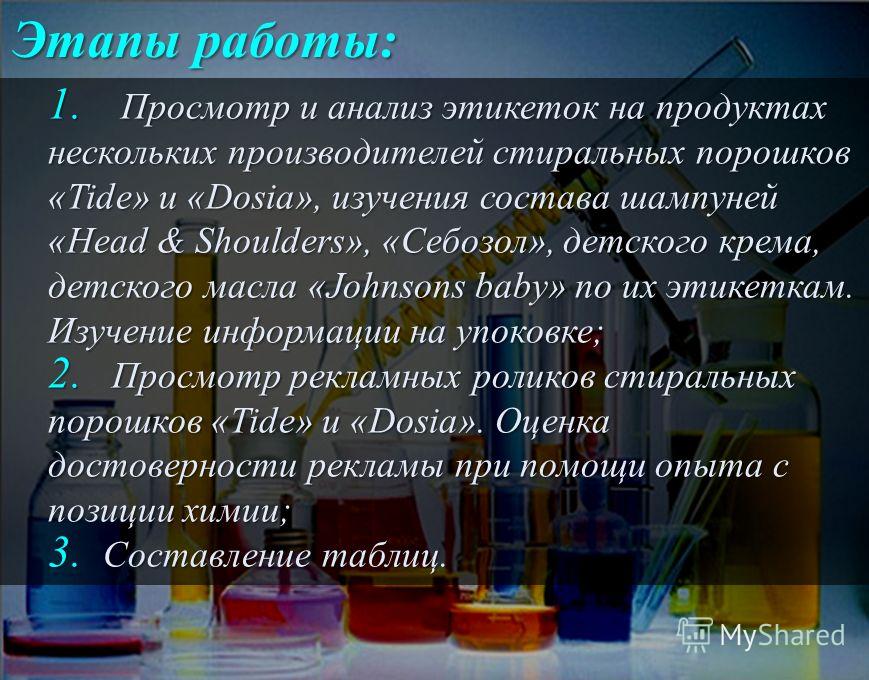
FOR THE RESEARCH OF THE RESEARCH: I CHALLENGED MYSELF TO CHECK THE VALIDITY OF ADVERTISING OF WASHING POWDERS. Then study the composition of washing powders, baby cream and oil, shampoos. Problem solving: For the experiment, I chose advertising for TIDE and DOSIA washing powders, baby cream, Johnsons baby oil, Head & Shoulders, Sebozol shampoos.

ABOUT THE DESCRIPTION OF THE STUDY I NEED TO CARRY OUT. Take "TIDE" and "DOSIA", "Head & Shoulders" and "Sebozol", baby cream and "Johnsons baby". Analyze the composition of each product. Take "TIDE" and "DOSIA", "Head & Shoulders" and "Sebozol" , baby cream and Johnsons baby. analyze the composition of each product. Take fabric soiled with four kinds of stains and soak in "TIDE" and "DOSIA". Take fabric soiled with four kinds of stains and soak in "TIDE" and "DOSIA". Analyze the results (estimated purity). Analyze the results (estimated purity). The results of the study are given in the table. The results of the study are given in the table.
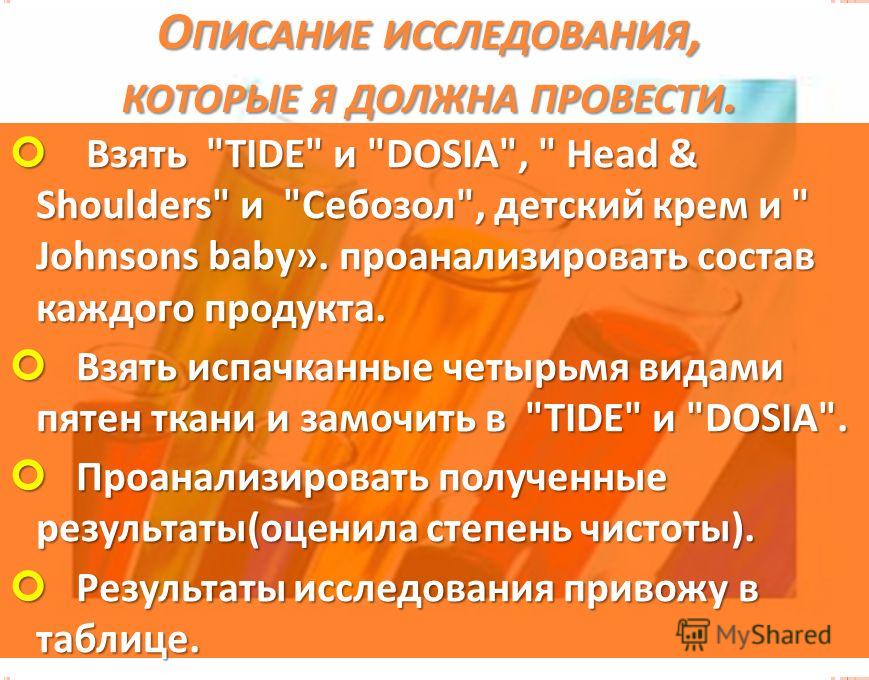

I STAGE. P BROWSING AND ANALYSIS OF LABELS ON PRODUCTS. View and analyze labels on the products of several manufacturers of Tide and Dosia washing powders, study the composition of Head & Shoulders, Sebozol, baby cream, and baby oil shampoos by their labels. Studying information on the package. View and analyze labels on the products of several manufacturers of Tide and Dosia washing powders, study the composition of Head & Shoulders, Sebozol shampoos, baby cream, Johnsons baby oil and their labels. Studying information on the package.
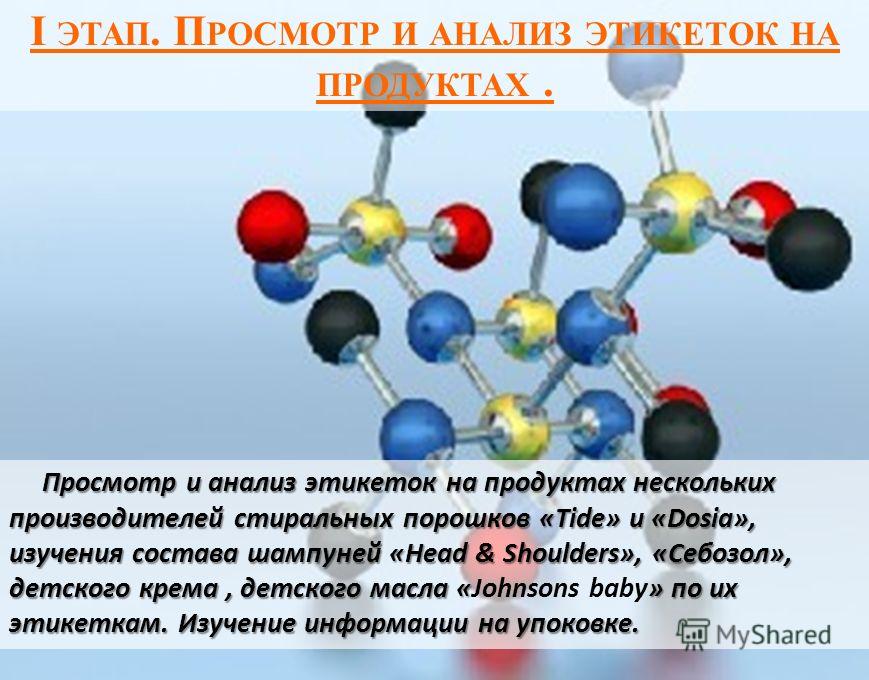

Powder composition: “TIDE” “DOSIA” 15-30% - anionic surfactants 15-30% - anionic surfactants phosphates, phosphates, less than 5% - cationic surfactants less than 5% - cationic surfactants oxygen-containing bleach oxygen-containing bleach nonionic surfactants nonionic surfactants optical enzymes optical brightener 5-15% anionic surfactants 15-30% water softening components oxygen-containing bleach less than 5% nonionic surfactants enzymes antifoam flavor
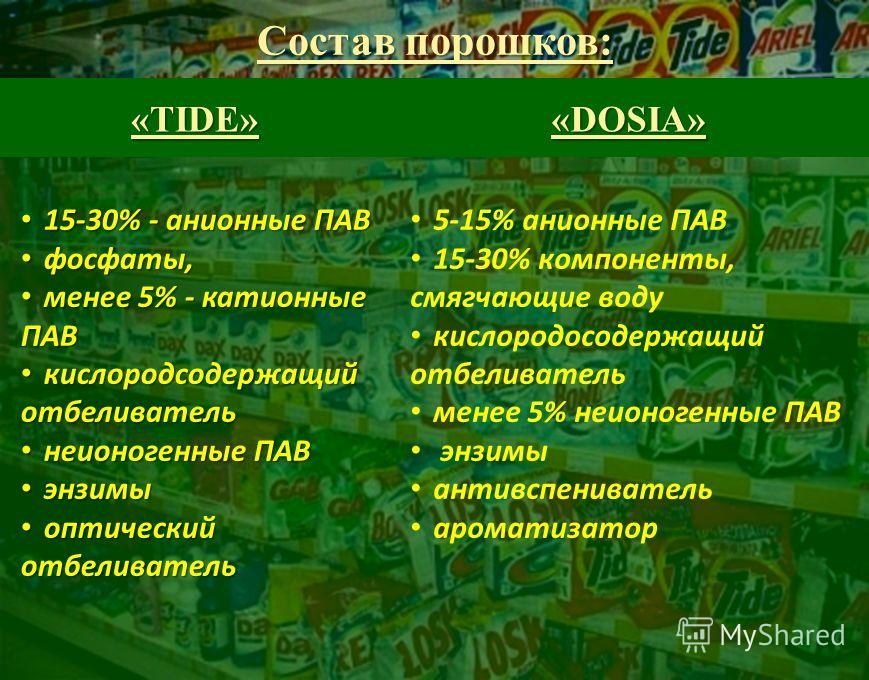

WITH SHAMPOO SHEET: Water (H2O) Water (H2O) Ammonium Lauryl Sulfate (C12H29NO4S) Ammonium Lauryl Sulfate (C12H29NO4S) Sodium Chloride (NaCl) Sodium Chloride (NaCl) Glycol Distearate Glycol Distearate Zinc Prion Prion Sodium Zinc Citrate 3 6 H 5 O 7) Sodium citrate (Na 3 C 6 H 5 O 7) Citric acid (C 6 H 8 O 7) Citric acid (C 6 H 8 O 7) Benzyl alcohol (C 7 H 8 O) Benzyl alcohol ( C 7 H 8 O) Water (H2O) Water (H2O) Sodium laureth sulfate Sodium laureth sulfate Sodium chloride (NaCl) Sodium chloride (NaCl) Ketoconazal Ketoconazal Glycerin (C 3 H 5 (OH) 3) Glycerin (C 3 H 5 (OH) 3) "Head & Shoulders" "Sebozol"

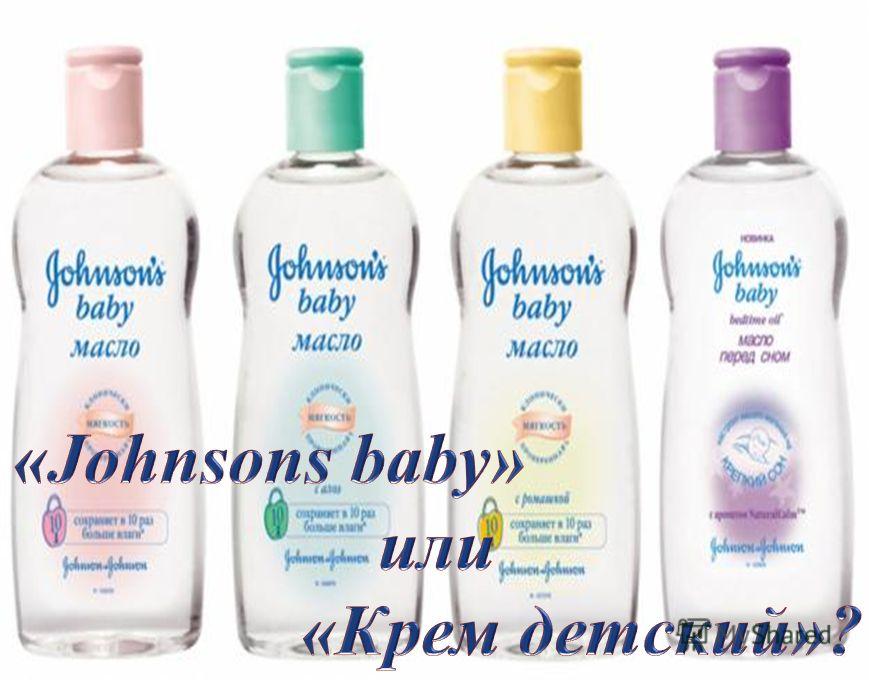
WITH OIL AND CREAM OIL: Vaseline oil Vaseline oil Isopropyl ether Isopropyl ether Aloe Barbadensis Aloe Barbadensis Vitamin E Vitamin E Perfume Perfume Glycerin (C 3 H 5 (OH) 3 Glycerin (C 3 H 5 (OH) 3 Oil Vaseline Oil calendula flower oil extract calendula flower aloe vera gel aloe vera gel CO2 extract CO2 chamomile extract Johnsons baby cream for children


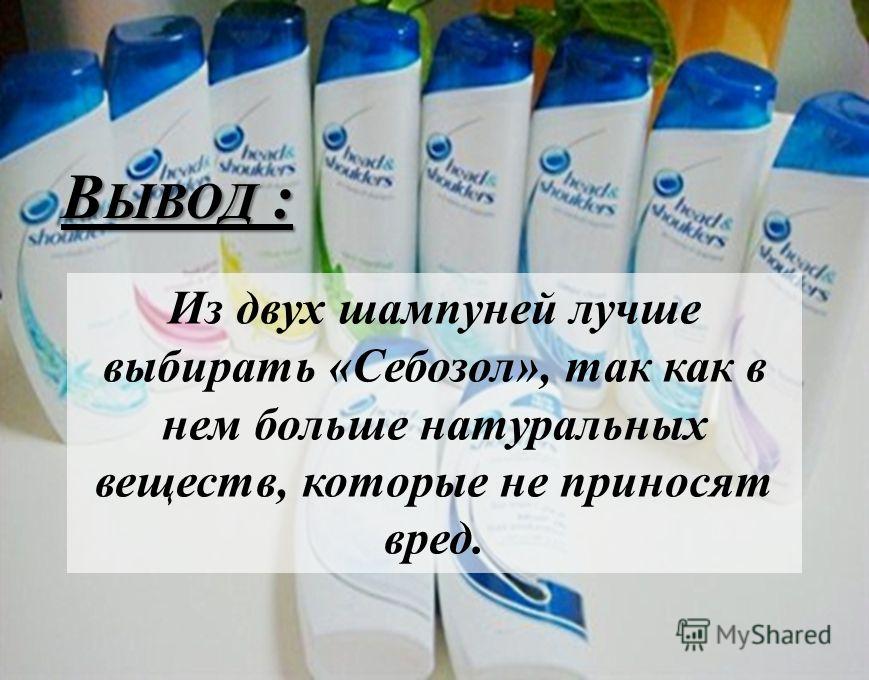


 CONCLUSION: We do not deny the need for advertising and its important role in the life of a modern person, but we urge you to be very thoughtful and critical of everything that advertising companies bring down on us from newspaper pages, from television screens, from numerous posters. leaflets and brochures. When reading any advertisement, try to find out if its content contradicts those laws or the concept of natural sciences that we study at school.
CONCLUSION: We do not deny the need for advertising and its important role in the life of a modern person, but we urge you to be very thoughtful and critical of everything that advertising companies bring down on us from newspaper pages, from television screens, from numerous posters. leaflets and brochures. When reading any advertisement, try to find out if its content contradicts those laws or the concept of natural sciences that we study at school.
![]()
Research work
TOPIC: Detergents for dishes and their properties. The effect of detergents on metal corrosion.
Introduction p. 2-3
Chapter 1. General Information on Dishwashing Detergents p. 4-5
1.1 Dishwashing detergents p. 4
1.2 the Composition of dishwashing detergents p. 4-5
Chapter 2. Diagnostics for dishwashing detergents p. 6-8
2.1.Diagnosis of the use of dishwashing detergents page 6
2.2. Composition, properties and characteristics of the use of detergents p. 7
2.3. Physico - chemical properties of dishwashing detergents. pg. 7-8
2.4. Effect of dishwashing detergent solutions on page 8
the course of corrosion of iron objects.
Conclusion page 9
References p. 10
Appendix page 10
Introduction
The twenty-first century is the time when information has become the foundation on which all spheres of human life rest. Therefore, each person must be sure that the information that he owns is reliable and will not bring him or others spiritual or physical damage. Streams of information reach us from everywhere, but the main source is the media. And often, even a person who is educated and wise in life experience cannot determine whether they are trying to deceive us using advertising tricks or just exaggerate the merits of the goods and services offered. Advertising has become an integral part of our lives. Sometimes it really helps to navigate the variety of goods and services, and sometimes it promises just “miracles”. Thanks to the active advertising policy of manufacturers, today almost every family uses special products for washing dishes. So, scientists have estimated that a Russian family of 4 people washes about 5 tons of dirty dishes every year! The first MS appeared more than 5000 years ago in the Middle East. But their role in our life has not changed so far. MS is currently used to remove various types of contamination: stains on clothes, rust, dirty dishes, etc.
The composition of dishwashing detergents is close to shampoos, shower gels. That is, to hygiene products. And they have special security requirements. All this is good, however, dishwashing detergents are considered as household chemicals. This means that they do not need a hygiene certificate that guarantees safety. The requirements are that for a toilet cleaner, for dishes - the same. Manufacturers may subject their products to a safety test, but voluntarily. Chemists acknowledge: this certificate only guarantees that at the time of use you will not be poisoned, do not spoil your skin. But what happens over time in the body, into which the remnants of the detergent constantly fall, have not been investigated.
With the ever-increasing number of new chemicals coming into circulation, actual problem is their study in order to obtain information on the potential hazard of substances and develop preventive measures to prevent adverse effects on the human body and the environment. Among a set of environmental factors subject to hygienic control, household chemical goods (TBH) deserve much attention in connection with their mass production and use, a variety of components that are part of the formulations, and also with a possible direct effect on the human body. As you know, after use, all chemicals enter the environment and adversely affect it, but we don’t think about it. Therefore, we decided to devote our work to household chemicals and, having studied the composition of MS for dishes, determine how safe their use is.
We believe that our work is very relevant today. We cannot do without MS, but their use often harms our world. To understand how to deal with the harm done to us by the MS, we must first of all learn more about them than is reported in the advertisement. We decided to conduct a study at our school in order to identify the funds that are most in demand and to analyze the reasons for the choice of participants in our study. Saying yes or no to MS is everyone’s business, but if certain rules are followed, then the health risk will be minimal.
Practical significance The work consists in the fact that the obtained information on the results of research can be used to educate the population of the village about the dangers of certain detergents, the negative impact of SMS on human health, and the increase in corrosion of metals from which plumbing is made.
purpose work: to study the physico-chemical properties of detergents, to investigate the effect of detergents on the corrosion of metals from which plumbing is made.
Tasks :
1. To study the literature on this issue;
2. Identify the most commonly used household detergent brands for dishes;
3. To study the composition, data of dishwashing detergents, using their labels.
4. Investigate the physico-chemical properties of detergents;
5. Consider the effect of detergents on metal objects (nail).
Object of study : liquid dishwashing detergents.
Subject of study: properties and safety of the use of detergents for dishes, metal corrosion.
Hypothesis: if you have complete information about the composition and properties of detergents, then You can maintain human health, prevent damage to plumbing made of iron.
In accordance with the objectives of the study, methods of systematization of theoretical material, research methods and methods of observation, generalization of the accumulated material were used.
Chapter 1. General information about dishwashing detergents
1.1 Means for washing dishes and their properties
Special dishwashing agents first appeared in the 1950s. Dishwashing liquid is available in the form of a liquid or gel. Gel-like products are considered more effective than liquid products.
The main properties of the product is its washing ability. A big plus of the product is its ability to effectively cope with oil and fat contamination in cold water, this is achieved by selecting the optimal surfactant composition.
Another important property of the dishwashing detergent is its gentle effect on the skin of the hands. It is worth noting that the statements of manufacturers that the pH level of their products is 5.5, in no way can guarantee the absence of irritation, especially in people prone to allergies. Therefore, when washing dishes, the skin needs protection. The product should contain emollients and do not forget that your hands can be protected from the harmful effects of the product with ordinary rubber gloves.
A lot can be said about the dishwashing detergent.
1.2 Composition dishwashing detergents
Detergents are based on surfactants. It is they who determine its washing ability.
Surfactants are divided into two types: ionic and nonionic (nonionic).
The fundamental difference is that nonionic surfactants are not subject to electrolytic dissociation, i.e. they do not decay in water into positively and negatively charged ions; ionic surfactants, when interacting with water, decompose into ions, some of which have adsorption (surface) activity, others (counterions) are adsorption inactive.
Ionic surfactants are called anionic if the surface-active ions carry a negative charge, and cationic if the surface-active positively charged ions. Some surfactants, depending on the conditions in which they are used, exhibit either anionic or cationic properties, therefore they are called amphoteric or ampholytic. Anionic surfactants - organic acids and their salts. Cationic - bases, usually amines, and their salts. In the global production of surfactants, most of the anionic substances.
Synthetic detergents necessarily contain a number of excipients that improve their washing ability. Detergent compositions sometimes include alkaline salts of weak inorganic acids (sodium carbonate and bicarbonate, sodium silicates, phosphates of various compositions), neutral salts (sodium chloride), peroxide salts with bleaching and disinfecting properties (sodium perborate and percarbonates). It is these chemicals that enter into chemical reactions with the metals from which plumbing is made, and the corrosion of metals occurs under the influence of these substances. Corrosion leads to billions in losses every year, and resolving this problem is an important task. The main damage caused by corrosion is not in the loss of metal as such, but in the enormous cost of products destroyed by corrosion. That is why the annual losses from it in industrialized countries are so great.
An important role is played by the organic components of surfactants: carboxymethyl cellulose, which prevents the re-deposition of contaminants from the washing solution onto the washed surface, and the so-called hydrotropes, which increase the solubility and accelerate the dissolution of surfactants in water.
Some detergents contain enzymes that remove insoluble protein contaminants, organic bactericides, foam stabilizers.
Aromatic substances (fragrances) are added to many detergents, designed to eliminate unpleasant odors and give a washed surface a fresh aroma. True, the smell of apple, lemon or, for example, wild berries does not mean the presence in this product of extracts of the above fruits.
Also, dishwashing detergents may include substances that mitigate the negative effects on the skin of the hands. The most common supplements are glycerin, silicone, and herbal extracts. Glycerin and silicone have a similar effect, they create a protective film on the skin that prevents it from drying out. At the same time, the surface film created by silicone is able to protect against the penetration of substances harmful to the skin contained in the detergent.
Plant extracts soften the skin, have a calming effect, relieve irritation that can be caused by individual components of surfactants (for example, aloe vera milk has this effect). But even with all the undoubted advantages of these supplements, it is impossible to guarantee your skin complete safety.
Chapter 2. Diagnostics of detergents for dishes
Diagnosis of the use of dishwashing detergents.
In order to find out which of the means are the most used, we interviewed students, teachers and school workers. The survey involved 50 people.
Survey data show that the most popular is Fairy. It is used by 19 people among the respondents, which is 38%. Further in descending order of popularity are: “AOS” - 11 people, 22%; “Myth” - 7 people, 14%; SORTI - 7 people, 14%; “Drop” - 6 people, 12%.
2.2. Composition, properties and characteristics of the use of detergents.
To study the composition, properties, features of the use of dishwashing detergents, the labels of the products specified during the questioning of users were studied. As a rule, no one reads the instructions for washing dishes, but this does not relieve the manufacturer from the need to put this information on the label.
The research data are shown in table 1.
Table 1.
Composition, properties and characteristics of the use of detergents.
Fairy
AOS
MYTH
SORTI
A drop
Volume / ml
Price, rub.
Shelf life
18 months
18 months
18months
18 months
24 months
Composition
5-15% anionic and nonionic surfactants, fragrance, preservative, citroneplol, limonene and linalool.
5-15% anionic and nonionic surfactants, ethylenediaminetetraacetic acid salt, flavoring agents, preservatives
anionic and nonionic surfactants, sodium chloride, citric acid, preservative, perfume composition, citric acid
Water, anionic and nonionic surfactants, ethylenediaminetetraacetic acid salt, flavoring agents, preservatives,
Water, surfactant,
sodium chloride, citric acid, preservative, perfume composition, citric acid,
apply a small amount to a damp sponge
Drop a few drops on a damp sponge
Drop a few drops on a damp sponge
Apply a small amount to a damp sponge.
6. Precautions
In case of contact with eyes, rinse with water
Keep out of the reach of children.
Protect from sunlight. Keep away from heaters. Keep out of the reach of children. In case of contact with eyes, rinse with water.
Keep away from children, avoid contact with eyes.
These tables allow you to do the following conclusions:
With an equal amount of detergent, the price of the products is not the same.
The more expensive products include Fairy, AOS, the cheaper ones are Myth, SORTI and Drop.
The shelf life of all products is almost the same.
The main component of MS are surfactants.
in addition to surfactants, detergents contain dyes, preservatives, perfume composition, but the labeling of these substances is not indicated, which does not allow us to conclude that they are safe for humans.
The exact amount of the product required for use is not indicated on the packages. It only says "apply a small amount on a sponge or on dishes" or "drip a few drops ...".
Almost all means, except "Fairy"Contain a warning:" Keep away from children "and describe the actions in case of contact with eyes.
Much attention is paid to the advertising label on the MS label: manufacturers indicate that all products effectively remove fat not only in hot but also in cold water, are easily washed off with water without leaving streaks. On the product label "Fairy"It is indicated that it complies with the RF standard for washability from dishes.
2.3. Physico - chemical properties of dishwashing detergents.
Experiment 1: Study of the pH of the solution.
One of the requirements for the use of dishwashing detergents is that they must have a neutral or slightly acidic pH of the solution (pH \u003d 5.5-7).
To determine the pH of the solution, we took a 0.1% solution of each agent, examined using an instrument for determining the pH of solutions. The results of the experiment are shown in table 2. Output: All products are pH neutral.
Table 2:
Chemical properties of dishwashing detergents.
IndexFairy
Aoc
Myth
SORTI
A drop
1. pH of the solution
7,68
7,7
7,7
6,0
6,0
Content
phosphates
-
-
-
-
-
Experience 2 : The phosphate content of dishwashing detergents .
The presence of phosphate additives in detergents leads to a significant increase in the toxic properties of surfactants. They penetrate the microvasculature of the skin, are absorbed into the bloodstream and spread throughout the body. This leads to a change in the physicochemical properties of the blood itself and impaired immunity.
A 0.1% solution of each agent was tested with silver nitrate. The tubes did not have yellow or white precipitation. A yellow precipitate indicates the presence of phosphate ions (Ag 3 PO 4) in the samples; a white precipitate indicates the presence of chloride ion (AgCl) in the samples. The results of the experiment are shown in table 2.
Output: No phosphate additives were found in detergents.
2.4. The influence of solutions of detergents for dishes on the course of processes
corrosion of iron objects.
During disposal, the used solutions of detergents for dishes are directly in contact with the metal pipes of the sewer, and when washing with metal dishes.
For the study, a 0.1% solution of each detergent was prepared and an iron nail 80 mm long was lowered into each. The experiment was carried out at room temperature. As a control sample, tap water was used. The experiment was carried out with triplicate.
On the first day, rust appeared on the nails in the following products: “AOS", "a drop SORTI". On the second day, a plaque of rust appeared in a test tube with tap water and on a nail dipped inFairy» . In the MIF tool, test tube rust appeared on the third day, while the nail remained clean. In the following days, the build-up of rust on the nails increased, moreover, the fastest means: “Fairy"," JSC S", "a drop SORTI". Rust was deposited at the bottom of the tubes — a brown precipitate. By the end of the observation, the height of the sediment was different in test tubes: “AOS"- 10mm," Fairy"-7mm," drop SORTI"- 9mm," MIF "- 4mm," Drop "-9mm, water - 3mm.
Output: all tested solutions of detergents for dishes contribute to increased corrosion of iron objects, and therefore negatively affect sewer pipes and metal utensils.
Final part
Conclusions:
The most popular among the population are: Fairy,
« AOS. "
Detergent labels contain a large amount of promotional promises,
but not complete information on the composition and labeling of the ingredients, on the method of application.
All products are highly soluble in water.
4. All products are pH neutral.
5. The products do not contain harmful phosphate additives.
6. All tested solutions of detergents for dishes contribute to increased corrosion of iron objects, and therefore negatively affect sewer pipes and metal utensils.
We want to advise you, it is more responsible for the choice of detergents and not allow ads to fool themselves. Do not forget that our children and grandchildren will live on this planet, and we must take care of their future and health. Also, do not forget that our environment suffers from the use of certain detergents. We also want to advise you to handle detergents more carefully and not to forget that they contain components that can cause rashes, chemical burns, irritations and allergies. Always read the safety precautions written on the back of the packaging and keep detergents away from children.
We are aware that the use of detergents by people cannot be stopped, or even reduced. Moreover, with the increase in the population of our planet, the number and variety of detergents inevitably increase, which adversely affect not only humans, but also the environment.
We hope that in the course of progress safer detergents will be invented that will be able to completely dissolve in water without forming harmful chemical compounds. The information obtained during the research work can be used in teaching the school course in chemistry, biology, ecology, classroom hours, in conversations with students and parents, in elective classes in chemistry and ecology.
Literature:
1. Ambramzon A.A. and others. Surfactants. Synthesis, analysis, properties,
application. L., 1988.
2. Ashikhmina T.Ya. School environmental monitoring. Teaching aid / Ed. T.Ya. Ashihmina. - M .: Agar, 2000.
3.Bogdanov I.I. Conversations about the ecology: Textbook. allowance. - Omsk, 1995.
4. Spausus Z. Travel to the world of chemistry. M .: "Enlightenment", 1967.
Schwartz A., Peri D. Surfactants: their chemistry and technical applications. M., 1953.
Kharlampovich G.D. and others. Many-sided chemistry. - M .: "Education", 2004
Applications
Observation: 11/4/15
Observation: 11/10/15

